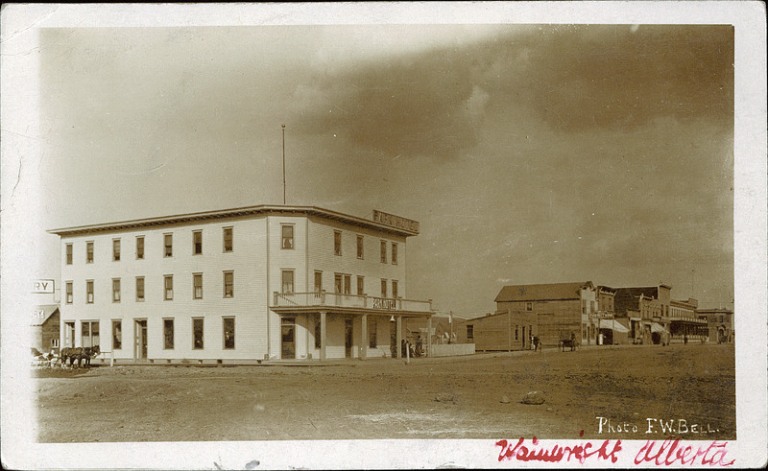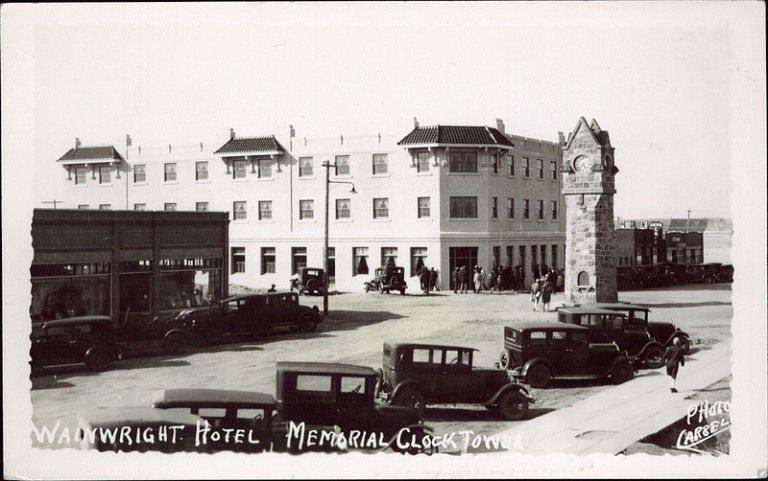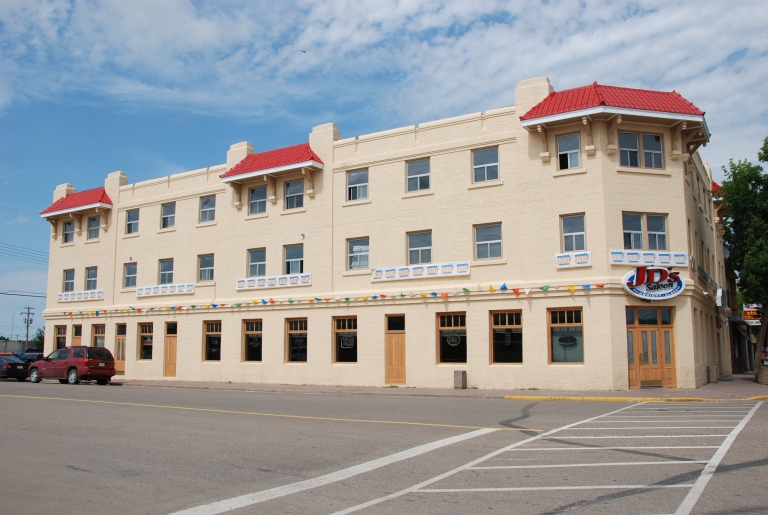This post was originally published on RETROactive on August 2, 2011. The last paragraph is an addition from another blog post featuring the Wainwright Hotel, New Uses for Old Places – The Wainwright Hotel, published on March 20, 2014.
When the Grand Trunk Pacific Railway completed its line between Saskatoon and Edmonton in 1908, vast tracts of land in east central Alberta south of the Canadian Northern line were opened up for homesteading. At key points along the line, the GTP erected stations and subdivided townsites. One of these was near a small community called Denwood, where a post office and store had been opened in 1907. The new townsite, to where Denwood residents and businesses now moved, was called Wainwright, after the second vice-president of the GTP. One of the structures moved from Denwood to Wainwright was the Denwood Hotel, which soon became the Wainwright Hotel. It was owned by M.L. Forster, a strong community minded individual who served on the first village council and was mayor of the Town of Wainwright from 1927 to 1935.
With rapid early growth, Wainwright became a village in July 1908, and a town with over 400 people in July, 1910. The Wainwright Hotel was joined by another hotel, the Park, in about 1912, but the Wainwright remained the main hotel in town, with room created for a tavern. Although business declined between 1917 and 1924, due to prohibition, the remodeled tavern did a lively business in the late 1920s under the management of a Mr. H.C. Link.

In 1929, the Wainwright Hotel was destroyed by fire, along with much of the business district. Because of the relative prosperity of the late 1920s, most commercial structures in Wainwright were rebuilt, including the Wainwright Hotel, which was larger and built of poured concrete, no doubt to prevent another fire. Most other commercial and public buildings were now built of brick.

Prosperity did not last, as the Great Depression of the 1930s saw grain prices tumble to such a degree that many district farmers did not bother to ship their grain to the Lakehead because they would lose money doing so. Business in the tavern probably suffered also. Not that people stopped going there, but, with the price of beer 10¢ a glass, people in rural Alberta were consuming less of the beverage. Illegal stills, a holdover from prohibition, were noted to be reappearing in isolated spots.
Wartime restrictions on alcohol consumption also hindered rural hotels, but, with war’s end, hotels like the Wainwright began to recover. With the advent of Ladies & Escorts sections in 1953, business probably improved. In the late 1960s, mixed drinking was allowed, and, in 1971, the age for public drinking was lowered from 21 years to 18. Many taverns could now entertain their customers with small local bands.
The Wainwright Hotel probably did a lively business during these years, and has remained standing since, serving the community and district as the main hotel for most of the 20thcentury. Its tavern, its chief source of revenue, was also no doubt the favourite watering hole for local and district residents for much of this time. In 2009, it was designated a Provincial Historic Resource.

Now owned by the Buffalo Park Foundation, the Wainwright Hotel is about to experience new life. The Foundation has been working closely with Heritage Conservation Adviser, Carlo Laforge to undertake work to establish a mixed-use facility that will contain the gallery, museum and archives of the Buffalo Park Centre as well as office and meeting space on the upper floors. To learn more about the work at the hotel, see this past blog post, or visit the Buffalo Park Foundation website.
Written by: David Leonard (Historian) and Rebecca Goodenough
Visit the Alberta Register of Historic Places to learn more about the heritage value of the Wainwright Hotel. In order for a site to be designated a Provincial Historic Resource, it must possess province-wide significance. To properly assess the historic importance of a resource, a historian crafts a context document that situates a resource within its time and place and compares it to similar resources in other parts of the province. This allows staff to determine the importance of a resource to a particular theme, time, and place. Above, is some of the historical information used in the evaluation of the Wainwright Hotel

